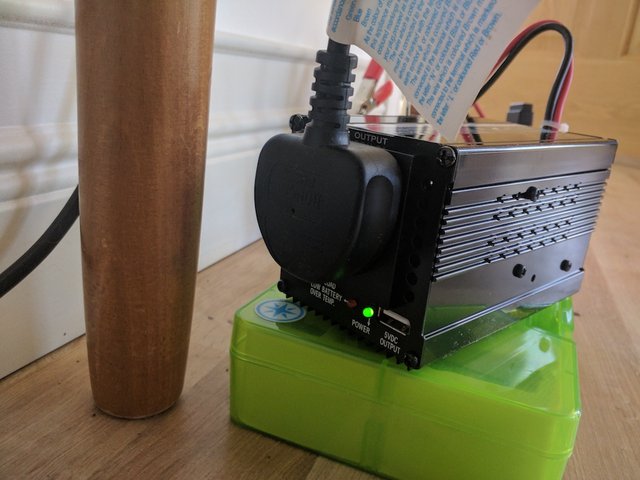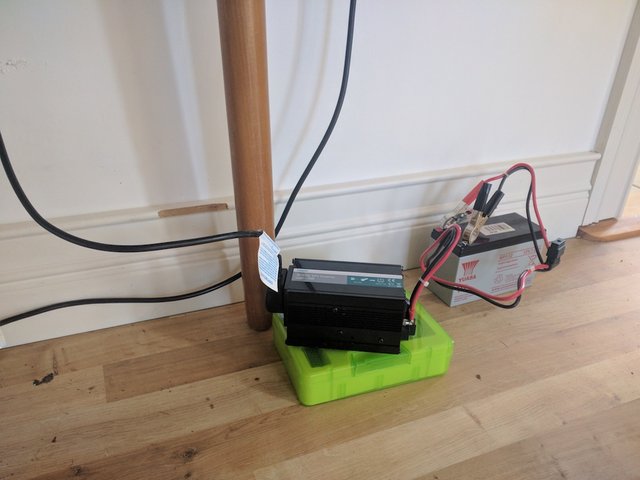Solar power project step 2, battery test with inverter
Part 1: initial purchase and testing
Last time I made a test circuit for charging two 12v 7 Ah lead acid batteries from a large 15W solar cell using a charging regulator. Things seemed to work out well with the simple set up.
If one part of a solar rig will be about charging the batteries, then the other part will be on their use. It's simple but maybe not quite as simple as it first appears.
The two batteries I have are lead acid 12v 7 Ah, which means 12 volts and a capacity of 7 Amp hours of DC current. That means that it will only work with electronic devices that take 12 volts exactly, and that don't need to much current (amps) or the battery will run out very quickly.
"7 Amp hours" doesn't mean that you have to use it on a device that draws 7 amps, though you can. If you run a device which draws 7 amps, it will power this device for 1 hour only. Conversely, it will power a device that draws 1 amp for 7 hours.
Thus we get this simple formula:
powering time (hours) = battery capacity (amp hours) / device current draw (amps)
Test device: a computer screen
During my working day I decided to see how long I could run one of my several computer screens for on one of the batteries. However the screen is configured to run from the mains, which in Ireland is 240 volts AC (alternating current) with a wide enough range of current requirements. How can you use a 12 volt DC (direct current) battery for that?
You need what is called an power inverter. These are most commonly used by the common person in cars, mobile homes or the various other holiday vehicles people use, such as boats. Since all of these use a standard 12v lead acid battery also, I can use one meant for these purposes for the smaller capacity batteries.
The power inverter takes the DC input at 12v and changes its form to AC and at a higher voltage, which is useful for a range of household devices.

This is the unit itself from the front, with a normal Irish / UK style plug such as we have here. There is also a USB output. The power inverter can supply a very wide range of wattage requirements, but the maximum normal load for the one I got was 300 W.
The screen was rated to work between 100-240 volts and would draw 1.5 amps. So for the 7 Ah battery our formula is:
7 / 1.5 = 4.6 = 4 hrs 36 mins
Let's see if that actually works

Results of test
The screen stayed powered on for almost exactly 3 hours. This is a significant amount less than the formula predicted, if the ratings are true and the battery was truly fully charged. It works out that it's only about 65% efficient. Maybe this isn't surprising as I have read that inverters cannot be completely efficient, and that's especially the case with cheaper ones, such as the one I got.
I should note that I stopped the battery when the inverter started to beep, which indicates low battery. I'm not sure what percentage of battery this happens at, but it's not at 0% as draining lead acid batteries completely is apparently bad for their continued storage and health.
Reflection
I'm not sure exactly how long at this point, but charging one of the batteries would take a long time, even on a sunny day. It's interesting to note how little utility you get out of it in your normal life. It has made be consider my energy usage in general.
In terms of the project, it is clear that it would be better to run devices that can directly accept the 12v from the batteries to not potentially waste energy doing conversions. The funny thing is the screen probably could work with 12v DC, I'm sure there's a transformer built into it to convert high voltage AC back to low voltage DC, so the inversion is itself inverted pointlessly.
Perhaps it would be best to run a home light rig from it first? I'm not sure but I'll think about it.
In any case I learned a few things from this testing and proved that everything works.
nice post! and good discussion to have here..
Its interesting to note as you say that MANY LED screen DO run on 12v DC.. They usually have an external transformer to do that for you.. Therefore with a LITTLE hacking you can adapt some screens to take a direct 12 VDC from a battery.. The screens that have an external transformer brick are EASY to do this with.. which is most of them i THINK
i havent tested this though so maybe use an old screen to test this idea with.. the only issue i see is that if you have too much charging you might have a voltage of 14V ish .. which MAY be fine but might not also.. TO avoid that problem you can use a solar charge controller with a stable 12V DC Output.. i have one,, its was very cheap and i use to give my LEDs an easy life..
https://www.ebay.com/itm/10A-12V-24V-Solar-Panel-Battery-Regulator-Automatic-Charge-Controller-USB/222558228389?hash=item33d1810fa5:g:G8EAAOSw3h1ZTy8T
oh and...
Congratulations @fourth your post had been selected for an upvote worth ~$1.87 as part of the @ecoTrain minnow support project. Your upvote will come soon!
I hope this encourages you to keep writing amazing posts and making this world a better place!.
JOIN US ON DISCORD
https://discord.gg/XwAmRWW
Good idea, I actually do have a LED screen that I'm not using and is quite old (by computer standards) so I might try that.
I have a battery regular already but I'm not sure exactly what it does, I think it just cuts off power draw when it decreases below a certain voltage threshold, I don't think it actually keeps voltage consistent. I'll see about getting one of those if not, thanks for the tip.
yeah im guessing your right.. they just cut off low and maybe high voltage and load.. most charge controllers dont provide a constant 12V..so i was very pleasantly surprised to see this one does.. im sure it will help keep things happier.. as electronics CAN be quite fussy about voltage.. especially IF you take off the transformer that used to do that job..
good luck mate!
Hopefully I can steer clear of voltage mishaps! Thanks, the testing continues.
yep! id say if its not charging then there no risk of over voltage.. undervoltage will most likley be just a switch off situation rather than burn out
Nice Post!
Thank you